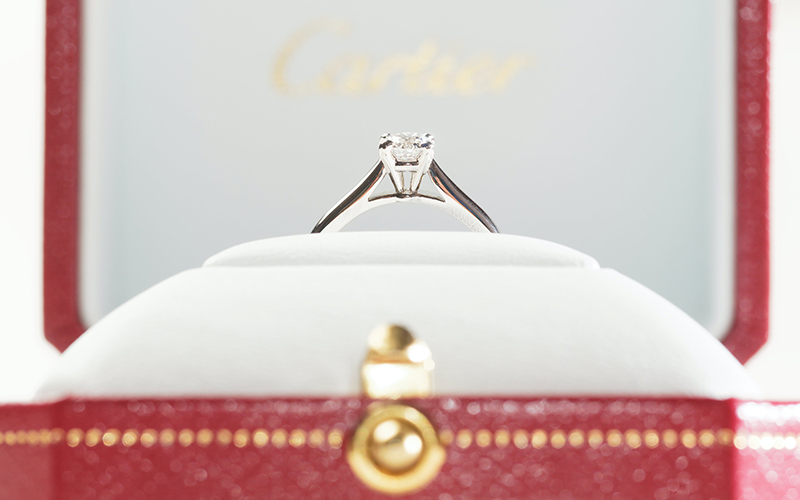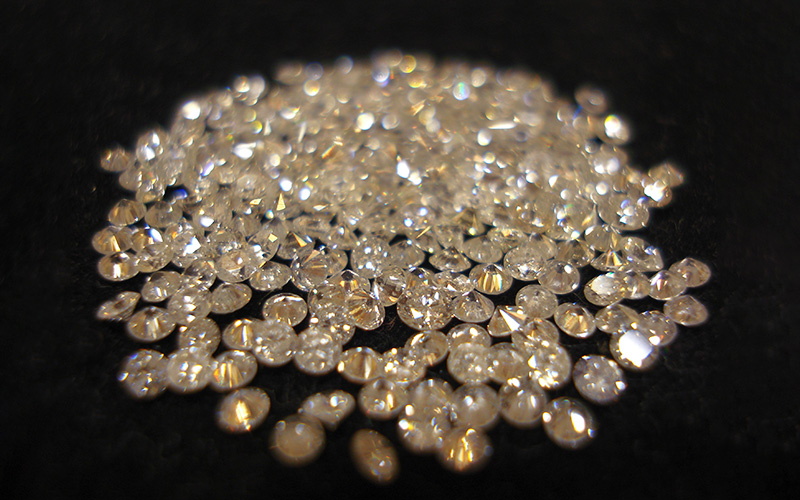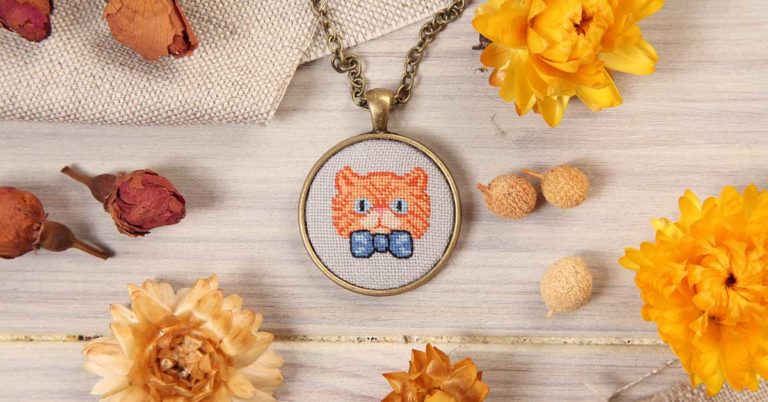According to Statista, the global jewelry market was valued at nearly $270 billion in 2022, of which luxury jewelry consisted of 28 billion Euros ($30 billion). The market is dominated by what’s known as fashion jewelry, but what is fashion jewelry vs fine jewelry anyway?
Interested in antique and vintage pieces? Check out our post, where we explain what estate jewelry is and how to shop for it.
What is fashion jewelry?
In short, fashion jewelry refers to affordable and arguably lower-quality pieces made from cheaper materials and using simpler manufacturing techniques.

Fashion jewelry is often made of materials that are used to simulate fine jewelry, such as brass made to look like gold or imitation gemstones created from plastic. For this reason, it’s often seen as fake.
However, this is not always the case. Fashion jewelry may be created from leather or cord as a stylistic choice, though it is typically mass-produced, rather than crafted by expert jewelers.
You may also hear the term “costume jewelry”, which is essentially the same thing as fashion jewelry. However, you can find high-end versions of costume jewelry, with creative and ornate designs made with imitation materials.
Well-made, vintage costume jewelry can even be a collectors’ item, and can be relatively expensive, though nowhere near the price of fine jewelry.
What is fine jewelry?
Fine jewelry sits at the other end of the scale: it is high-quality, expertly crafted from expensive materials, and typically has a price tag that reflects this. Unlike imitation fashion or costume jewelry, it’s the real deal; made from precious metals and gemstones.

True fine jewelry is well-made by experienced jewelers, and you can expect it to last for generations.
Though almost all fine jewelry is significantly more expensive than fashion pieces, the price can vary widely depending on the type of metal, the type and quality of the gemstones it contains (if any), and the jeweler who designed and made it.
For example, a pair of fine sterling silver earrings are a fraction of the cost of an 18k-platinum pair with 1-carat diamonds of high clarity. Excellent examples of antique fine jewelry made from precious materials can be even more expensive.
The world’s most expensive piece of jewelry, the Hope Diamond, has a history going back to the 17th century and has been valued at $250 million.
Fashion jewelry vs fine jewelry: The key differences
It’s important to understand the differences between fashion jewelry and fine jewelry, as unscrupulous sellers can label jewelry as “fine” when this may not be the case. This doesn’t necessarily mean that you should avoid fashion jewelry, but as a savvy consumer, you should know what you’re getting into, so that you can make wise purchasing decisions.
Price point
One of the most obvious differences is that fast fashion is much more affordable, though this comes with a different kind of cost. Like fast fashion, most of these pieces aren’t built to last and are essentially disposable: they’ll quickly break, but then you can just buy a new item, as they’re so cheap.
Obviously, this is not very responsible, as the manufacturing process uses precious resources as well as polluting the environment, and disposing of them at the end of the life cycle creates literal tons of non-biodegradable trash.
In contrast, fine jewelry is much more expensive, but it’s also much higher quality, so it’s likely to last you much longer before breaking. Furthermore, if something does become damaged or dull, it can usually be repaired, and the price point makes it worthwhile to do so!
It’s worth noting that the price of fine jewelry can vary widely depending on factors such as:
- The type and quality of metal
- The presence of gemstones and their type and quality
- The reputation of the designer
- The quality of craftsmanship
- The age of the piece and its history (antique pieces of known provenance and/or famous owners can be extremely valuable)
Craftsmanship
Craftsmanship is another key difference between fashion and fine jewelry, though it may or may not be so obvious.
The difference may be more subtle at first: fashion jewelry may appear well-made and more or less the same as a piece of fine jewelry. However, over time, its inferior quality is likely to show, whether it’s the thin metal plating wearing off, or the clasp breaking.

Furthermore, because of the cheaper materials it’s made from, fashion jewelry is not as easy to repair. If one of the links breaks on a fine necklace chain, you can easily take this to a jeweler to repair, and it will come back as good as new.
However, if the same thing happens with a piece of fashion jewelry, this may not be possible, or it may cost as much to repair it as it would to replace it.
Materials used
One of the key and most noticeable differences between fine and fashion jewelry is the materials the pieces are made from. Fine jewelry is made from precious materials and semi-precious materials, including metals like solid gold and platinum, and gemstones such as diamonds, sapphires, and emeralds.
Note that certain metals are classified in karats, a measurement of fineness. In gold and platinum, the karat rating indicates its purity as a proportion of 24: 24-karat gold in 99.9% pure, while 18-karat gold is 18 parts gold alloyed with six parts of other metals.
This is not to be confused with carats, which is a measurement of weight in gemstones. One carat is equal to 200 milligrams, or 0.007 ounces.

Source: Wikimedia / Swamibu
Although you’ll most commonly hear this in reference to diamonds, all precious gemstones, like rubies, emeralds, and sapphires, are also measured in carats. You’ll often find precious stones in fractions of carats, such as ½ carat or ¼ carat.
In contrast, fashion jewelry is made from cheaper materials, such as base metals such as copper and brass, as well as leather, plastic, glass, and man-made gems.
Quite often, these materials can discolor the skin: some people find that their skin turns green when exposed to the brass or copper used in fashion jewelry.
This is also because many of these kinds of pieces have only a thin protective coating that quickly rubs off with wear, exposing the skin to the metal.
Ethical and sustainable jewelry options
We already covered how the disposable nature of fashion jewelry makes it inherently unsustainable. However, fine jewelry is often more eco-friendly in other ways too: increasingly, fine jewelers are offering ethical and sustainable pieces.
This is by no means universal: not all fine jewelry pieces are eco-friendly, nor ethical. The global gold industry is highly pollutive: just one gold ring can produce 20 tons of toxic waste.
The diamond industry can be equally destructive: not only does the process use huge amounts of water and energy, as well as producing high levels of carbon emissions, but diamond miners sift through 250 tons of earth to uncover just one carat of diamond. This, in turn, contributes to soil erosion, deforestation, habitat destruction, and species extinction.
Sourcing diamonds, gold, and other precious materials can also be incredibly harmful to the environment and to humans. Gold and diamond mining continue to involve unsafe working conditions, child labor, and modern slavery.
However, you can find fine jewelry manufacturers and retailers who responsibly make pieces from sustainable and ethically-sourced materials, and these numbers are increasing all the time.
Some of our favorite sustainable and ethical jewelers are:
It’s much harder to do this for fashion jewelry. Apart from a few notable exceptions, the vast majority of fashion jewelry is mass-produced for the lowest possible cost.
As with any kind of product, producing items as cheaply as possible invariably means that the environment suffers.
Depending on the labor laws in the country where it’s manufactured, minimizing production costs may also mean exploitative labor conditions and even the use of child and forced labor.
What about semi-fine jewelry?
Semi-fine jewelry shares many of the same attributes as fine jewelry: it is well-made from high-quality, genuine materials, rather than imitations. However, many professionals will classify necklaces, earrings, or rings as semi-fine if they are made from semi-precious stones or semi-precious metals.
It can be an excellent choice if you want the quality and durability of fine jewelry but can’t afford the high price tag.
Semi-fine jewelry may feature:
- Sterling silver
- 18k gold plated over sterling silver (rather than solid gold)
- Semi-precious stones like garnets, amethysts, topaz, or opals

In contrast, a piece is usually considered fine if it is made from:
- Solid gold or solid platinum
- Precious gems such as diamonds, sapphires, emeralds, and rubies
This is not necessarily a hard and fast term. Some jewelers may classify a sterling silver or 14k gold piece as semi-fine, while others will label it as fine jewelry.
How to tell if your jewelry is real or fake
When shopping for jewelry, it’s important to be able to spot a fake. Otherwise, you may end up paying way too much for a piece or simply end up with something that’s different from what you expected.
The only way to know for sure is to consult an independent expert, but there are a few quick tests you can try for yourself:
- Gently place a gold ring in a container of water: solid gold is very dense and will sink quickly, so if it floats or sinks slowly, it’s probably fake.
- You can also spot fake or plated gold by using a magnet: gold is not magnetic, so if the piece sticks to the magnet, it must contain at least some proportion of another metal.
- Look for a hallmark or stamp that shows the purity level of the metal: gold and platinum pieces should bear a number such as 14k or 18k or a number like 583 (14k) or 750 (18k). This will be somewhere that’s not easy to spot when it’s being worn, such as inside a ring or on the back of a pendant.
- For gemstones, look at the cut: if the stone is very even and symmetrical, it’s probably glass that has been machine cut. Even a high-quality diamond will have a few flaws, so a perfect gem is probably a cubic zirconia.
- Cubic zirconia and inexpensive crystals may show all the colors of the rainbow, while diamonds are typically clear, though you really need an expert eye to be sure.
- Try the fog test on a sapphire: breathe on the stone until it fogs, and wait for it to evaporate. Real sapphires don’t hold onto water vapor well so it will quickly evaporate, whereas a fake glass stone will hold the vapor for around five seconds.
If you really want to check if a piece is real or fake, take it to an independent, professional jeweler who can use expert equipment to verify whether the metals and gemstones are real, and check the craftsmanship.
Fashion jewelry vs fine jewelry: Which is better?
Both can be beautiful and can be made in any kind of design or style. Fashion jewelry is not necessarily inferior to fine jewelry: you can find stunning, well-made pieces that just happen to be made from non-precious materials.
However, all too often, fashion jewelry is poorly made from cheap materials, and won’t last you long before it becomes unwearable. Overall, fine jewelry is a better choice because it is much more likely to be made from fine materials using expert craftsmanship.
These are pieces that will last not only a lifetime but several, and you can pass them down to future generations or use them as an investment.
Of course, not everyone can afford fine jewelry. Semi-fine jewelry can be a great compromise: it’s well-made from quality materials, even if it doesn’t feature diamonds encased in solid gold or platinum.
And if you are interested in making your own pieces, check out these best jewelry making classes to get started.











